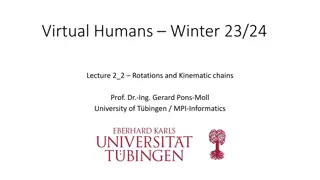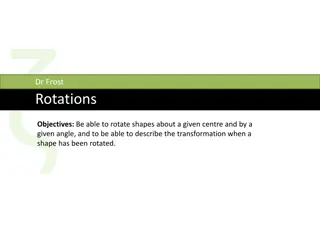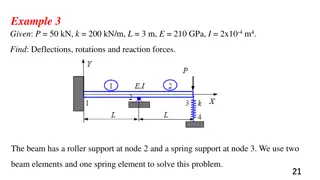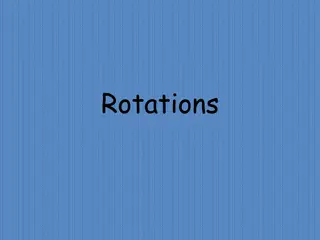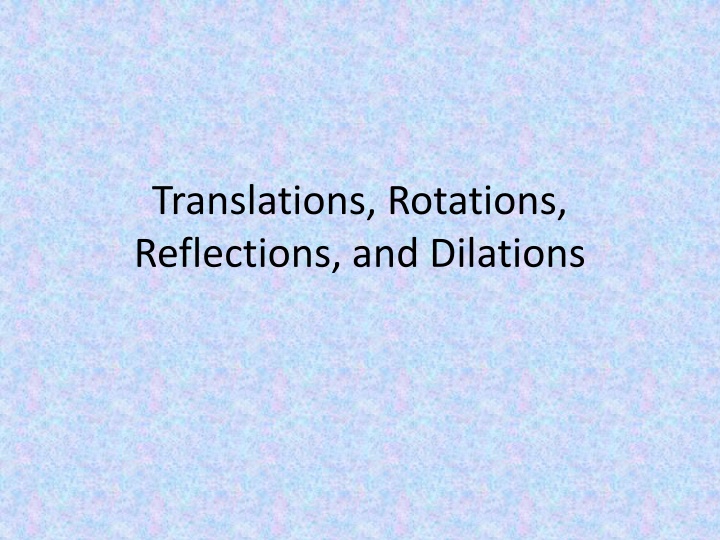
Geometric Transformations: Translations, Rotations, Reflections, and Dilations
Explore the world of geometric transformations, including translations, rotations, reflections, and dilations. Learn how each type of transformation changes the position and size of figures in geometry, with clear examples and explanations provided.
Download Presentation

Please find below an Image/Link to download the presentation.
The content on the website is provided AS IS for your information and personal use only. It may not be sold, licensed, or shared on other websites without obtaining consent from the author. If you encounter any issues during the download, it is possible that the publisher has removed the file from their server.
You are allowed to download the files provided on this website for personal or commercial use, subject to the condition that they are used lawfully. All files are the property of their respective owners.
The content on the website is provided AS IS for your information and personal use only. It may not be sold, licensed, or shared on other websites without obtaining consent from the author.
E N D
Presentation Transcript
Translations, Rotations, Reflections, and Dilations
In geometry, a transformation is a way to change the position of a figure.
In some transformations, the figure retains its size and only its position is changed. Examples of this type of transformation are: translations, rotations, and reflections In other transformations, such as dilations, the size of the figure will change.
TRANSLATION A translation is a transformation that slides a figure across a plane or through space. With translation all points of a figure move the same distance and the same direction.
TRANSLATION Basically, translation means that a figure has moved. An easy way to remember what translation means is to remember A TRANSLATION IS A CHANGE IN LOCATION. A translation is usually specified by a direction and a distance.
TRANSLATION What does a translation look like? original image x y Translate from x to y A TRANSLATION IS A CHANGE IN LOCATION.
TRANSLATION In the example below triangle A is translated to become triangle B. A B Describe the translation. Triangle A is slide directly to the right.
TRANSLATION In the example below arrow A is translated to become arrow B. A B Describe the translation. Arrow A is slide down and to the right.
ROTATION A rotation is a transformation that turns a figure about (around) a point or a line. Basically, rotation means to spin a shape. The point a figure turns around is called the center of rotation. The center of rotation can be on or outside the shape.
ROTATION What does a rotation look like? center of rotation A ROTATION MEANS TO TURN A FIGURE
ROTATION The triangle was rotated around the point. This is another way rotation looks center of rotation A ROTATION MEANS TO TURN A FIGURE
ROTATION If a shape spins 360 , how far does it spin? All the way around 360 This is called one full turn.
ROTATION If a shape spins 180 , how far does it spin? Half of the way around Rotating a shape 180 turns a shape upside down. 180 This is called a turn.
ROTATION If a shape spins 90 , how far does it spin? One-quarter of the way around 90 This is called a turn.
ROTATION Describe how the triangle A was transformed to make triangle B A B Describe the translation. Triangle A was rotated right 90
ROTATION Describe how the arrow A was transformed to make arrow B B A Describe the translation. Arrow A was rotated right 180
ROTATION When some shapes are rotated they create a special situation called rotational symmetry. to spin a shape the exact same
ROTATIONAL SYMMETRY A shape has rotational symmetry if, after you rotate less than one full turn, it is the same as the original shape. Here is an example As this shape is rotated 360 , is it ever the same before the shape returns to its original direction? Yes, when it is rotated 90 it is the same as it was in the beginning. 90 So this shape is said to have rotational symmetry.
ROTATIONAL SYMMETRY A shape has rotational symmetry if, after you rotate less than one full turn, it is the same as the original shape. Here is another example As this shape is rotated 360 , is it ever the same before the shape returns to its original direction? Yes, when it is rotated 180 it is the same as it was in the beginning. So this shape is said to have rotational symmetry. 180
ROTATIONAL SYMMETRY A shape has rotational symmetry if, after you rotate less than one full turn, it is the same as the original shape. Here is another example As this shape is rotated 360 , is it ever the same before the shape returns to its original direction? No, when it is rotated 360 it is never the same. So this shape does NOT have rotational symmetry.
ROTATION SYMMETRY Does this shape have rotational symmetry? Yes, when the shape is rotated 120 it is the same. Since 120 is less than 360 , this shape HAS rotational symmetry 120
REFLECTION REFLECTION
REFLECTION A reflection is a transformation that flips a figure across a line. A REFLECTION IS FLIPPED OVER A LINE.
REFLECTION Remember, it is the same, but it is backwards After a shape is reflected, it looks like a mirror image of itself. A REFLECTION IS FLIPPED OVER A LINE.
REFLECTION The line that a shape is flipped over is called a line of reflection. distance from the line of reflection on both sides. Notice, the shapes are exactly the same The line of reflection can be on the shape or it can be outside the shape. Line of reflection A REFLECTION IS FLIPPED OVER A LINE.
REFLECTION Determine if each set of figures shows a reflection or a translation. A C B C B A A REFLECTION IS FLIPPED OVER A LINE.
REFLECTION Sometimes, a figure has reflectional symmetry. This means that it can be folded along a line of reflection within itself so that the two halves of the figure match exactly, point by point. Basically, if you can fold a shape in half and it matches up exactly, it has reflectional symmetry.
REFLECTIONAL SYMMETRY An easy way to understand reflectional symmetry is to think about folding. Do you remember folding a piece of paper, drawing half of a heart, and then cutting it out? What happens when you unfold the piece of paper?
REFLECTIONAL SYMMETRY Line of Symmetry Reflectional Symmetry means that a shape in a figure with reflectional The line of reflection The two halves are exactly the same can be folded along a line of reflection so symmetry is called a line of symmetry. The two halves make a whole heart. They are symmetrical. the two haves of the figure match exactly, point by point.
REFLECTIONAL SYMMETRY The line created by the fold is the line of symmetry. How can I fold this shape so that it matches exactly? A shape can have more than one line of symmetry. Where is the line of symmetry for this shape? I CAN THIS WAY NOT THIS WAY Line of Symmetry
REFLECTIONAL SYMMETRY How many lines of symmetry does each shape have? Do you see a pattern?
REFLECTIONAL SYMMETRY Which of these flags have reflectional symmetry? No United States of America Canada No Mexico England
CONCLUSION We just discussed three types of transformations. See if you can match the action with the appropriate transformation. FLIP SLIDE TURN REFLECTION TRANSLATION ROTATION
Translation, Rotation, and Reflection all change the position of a shape, while the size remains the same. The fourth transformation that we are going to discuss is called dilation.
DILATION Dilation changes the size of the shape without changing the shape. When you go to the eye doctor, they dilate you eyes. Let s try it by turning off the lights. When you enlarge a photograph or use a copy machine to reduce a map, you are making dilations.
DILATION Enlarge means to make a shape bigger. Reduce means to make a shape smaller. The scale factor tells you how much something is enlarged or reduced.
DILATION Notice each time the shape transforms the shape stays the same and only the size changes. 200% 50% ENLARGE REDUCE
DILATION Look at the pictures below Dilate the image with a scale factor of 75% Dilate the image with a scale factor of 150%
DILATION Look at the pictures below Dilate the image with a scale factor of 100% Why is a dilation of 75% smaller, a dilation of 150% bigger, and a dilation of 100% the same?
Lets try to make sense of all of this TRANSFORMATIONS CHANGE THE POSTION OF A SHAPE CHANGE THE SIZE OF A SHAPE TRANSLATION ROTATION REFLECTION DILATION Change in location Turn around a point Flip over a line Change size of a shape
See if you can identify the transformation that created the new shapes TRANSLATION
See if you can identify the transformation that created the new shapes Where is the line of reflection? REFLECTION
See if you can identify the transformation that created the new shapes DILATION
See if you can identify the transformation that created the new shapes ROTATION
See if you can identify the transformation in these pictures? Maldivian reflection REFLECTION
See if you can identify the transformation in these pictures? ROTATION
See if you can identify the transformation in these pictures? TRANSLATION
See if you can identify the transformation in these pictures? DILATION


